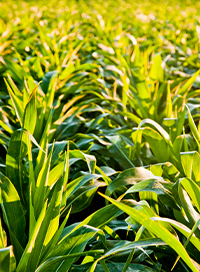 Depending on market prices, you may decide growing continuous corn is the right move for your farming operation. Planting corn on the same acres year after year can help you take advantage of good prices and offers other benefits, like the buildup of organic matter in the soil. But, along with the pros of planting continuous corn, there are cons — the main concern being that weed control can be a challenge.
Depending on market prices, you may decide growing continuous corn is the right move for your farming operation. Planting corn on the same acres year after year can help you take advantage of good prices and offers other benefits, like the buildup of organic matter in the soil. But, along with the pros of planting continuous corn, there are cons — the main concern being that weed control can be a challenge.
“If you’re not rotating to soybeans, alfalfa or small grains and you’re just focusing on corn, you might be using the same types of herbicides or the same families of herbicides over and over again in your corn,” says Jeff Moon, market development specialist for Corteva Agriscience in Minnesota and Wisconsin.
Moon says it’s easier to prevent weed resistance from developing when you switch crops and herbicides each year. That way, you’re using different chemistries to control the weeds in your fields.
However, when you continuously plant one crop, you’re more likely to repeatedly use the same chemistries. That gives weeds the chance to develop resistance against those specific solutions, making the weeds harder to control.
Luckily, you can take steps to make sure this doesn’t happen. The most important is to make sure you’re using a herbicide program approach with multiple modes of action.
A Program Approach
When it comes to creating the right program approach for your continuous cornfields, Moon says, you need to know what kinds of weeds you’re fighting. That way, you can “make sure you’re addressing the weeds that are out there with the appropriate chemistry,” he says.
Once you know which weeds you need to control, you can choose a preemergence herbicide with residual activity and then you’ll want to do a second pass with a postemergence herbicide.
If, for example, you have waterhemp, you could control it by applying SureStart® II herbicide preemergence, followed by Realm® Q herbicide postemergence. Those two solutions alone give you four modes of action. Then you could tank-mix each of them with other appropriate chemistries to add more modes of action.
In the future, you could possibly tank-mix SureStart II and Resicore® herbicide preemergence or try a different solution like Keystone® NXT herbicide or Cinch® ATZ herbicide.
Beyond the Program Approach
Beyond using multiple modes of action in a program approach, there are cultural practices you can use to control weeds in continuous corn.
Tillage can be one of those practices if your operation allows it. However, you have to be careful when using tillage for weed control. You want to make sure to till vigorously enough so you don’t just injure any standing weeds, as they will have a harder time taking in herbicides and be even more difficult to eradicate. So, keep in mind this might not always be a feasible plan for you.
You’re seed trait selection can also play a part in weed control. Be sure to choose seeds with herbicide-resistant traits for the chemistries you need to control the weeds you have.
It’s always a good idea to talk through your plans with your crop consultant to make sure they’ll work for you and your acres.
In the end, Moon says the most important thing to remember is to have a program approach in place and make sure you’re alternating several, different modes of action. “If you just use the same thing over and over again, you could get yourself into trouble,” he says.
Avoid that trouble this spring by finding the right herbicides for your farm on the Corn Herbicides Portfolio page on Corteva.us.
Cinch® ATZ and Keystone® NXT are Restricted Use Pesticides. Cinch ATZ, Realm® Q, Resicore® and SureStart® II are not registered for sale or use in all states. Keystone NXT is not available for sale, distribution or use in all states. Keystone NXT, Resicore and SureStart II are not available for sale, distribution or use in Nassau and Suffolk counties in the state of New York. Contact your state pesticide regulatory agency to determine if a product is registered for sale or use in your state. Always read and follow label directions.
The More You Grow
Find expert insights on agronomics, crop protection, farm operations and more.